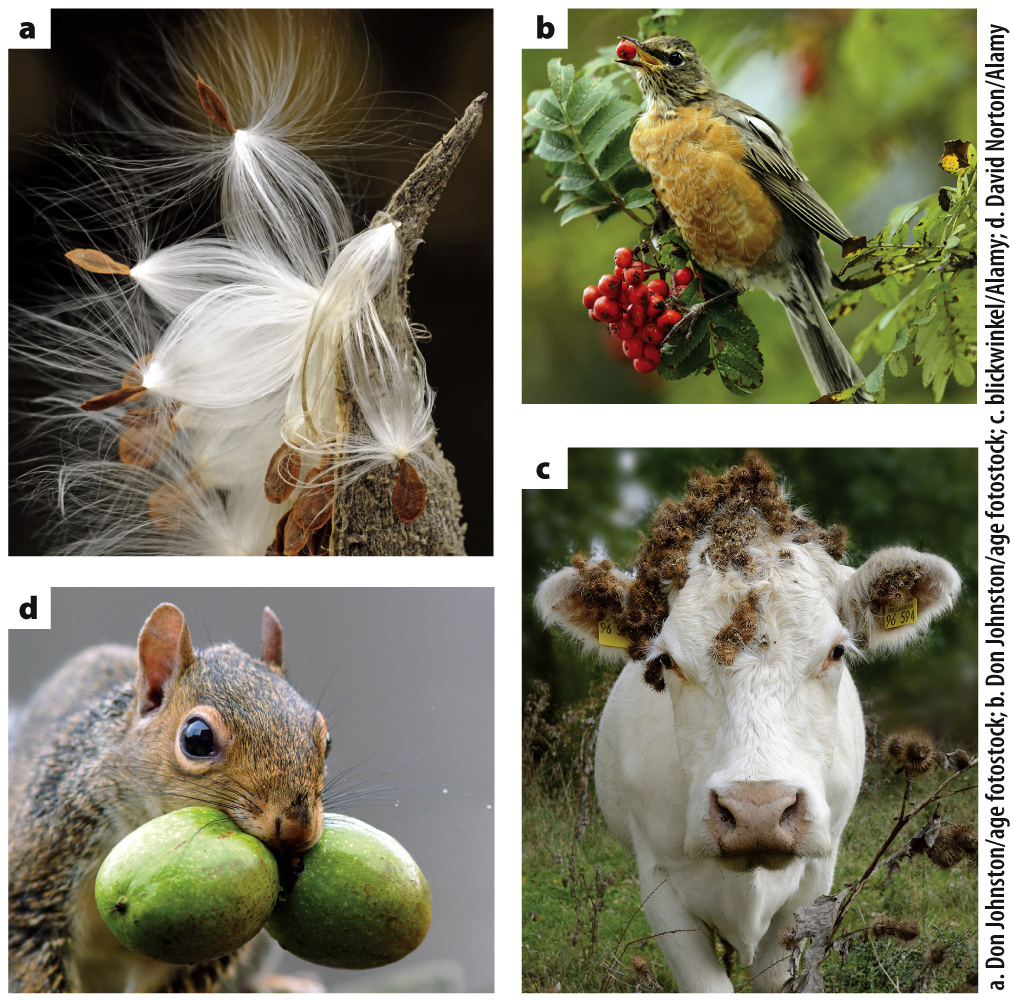Fruits enhance the dispersal of seeds.
The transformation of a flower into a fruit is as remarkable as the metamorphosis of a caterpillar into a butterfly (Fig. 30.21). As the fertilized egg develops to form an embryo and the endosperm proliferates around it, the ovary wall develops into a fruit, stimulated by signaling molecules produced by the endosperm. In a tomato, for example, the fleshy fruit is a mature ovary that encloses the seeds. In some plants, other parts of the flower may also become incorporated into the fruit. For instance, the fleshy part of an apple is formed from the outer part of the ovary combined with the base of the petals and sepals. Other fruits, like pineapple, develop from multiple flowers.

Fruits serve two functions: They protect immature seeds from being preyed on by animals, and they enhance dispersal once the seeds are mature. In the case of fruits dispersed by animals, it is essential that the fruit not be consumed before the seeds are able to withstand a trip through their disperser’s digestive tract. Thus, immature fleshy fruits are physically tough and their tissues highly astringent. As they ripen, the fruits are rapidly transformed in texture, palatability, and color. Ripening converts starches to sugars and loosens the connections between cell walls so that the fruit becomes softer.
In a number of species, including apples, bananas, and tomatoes, a gaseous hormone called ethylene triggers fruit ripening. It is the production of ethylene that explains why placing a ripe apple and an unripe banana together hastens the ripening of the banana. Tomatoes and bananas are usually picked in an immature state and are subsequently ripened by exposure to ethylene. The fruits can therefore be transported while they are still hard and less prone to damage. Because ethylene synthesis requires oxygen, the unripe fruits are typically stored in a low-
The tremendous diversity of form seen in fruits reflects the many ways in which angiosperm seeds are dispersed (Fig. 30.22). The winged fruit of an ash tree is carried away on the wind, and a coconut can float on ocean currents for many months, protected from exposure to salt water by its thick outer husk. The burdock fruit has small hooks that attach to fur (or clothing)—this small hitchhiker was the inspiration for Velcro. Other fruits are not dispersed, but instead open to expose their seeds. For example, as milkweed fruits mature and dry out, they split apart to release hundreds of seeds, each with a tuft of silky hairs that floats them away on even a light breeze. Still others, such as Impatiens (jewelweed), produce fruits that forcibly eject their seeds.

Animals are probably the most important agents of seed transport, in many cases attracted by the nutritious flesh of the fruit. In fleshy fruits, the seeds are protected by a hard seed coat and pass unharmed through the animals’ digestive tract. In some species, this passage actually enhances germination rates. In many cases, however, the seed is consumed, and successful dispersal occurs only when the animals gather more seeds than they eat. Squirrels are a good example, storing many acorns that never get eaten. Humans are an important dispersal agent—
Quick Check 6 From what flower structure(s) is a fruit derived?
Quick Check 6 Answer
A fruit forms from the ovary that encloses the seeds, and, in some plants, it also forms from other parts of the flower, including the petals and sepals.